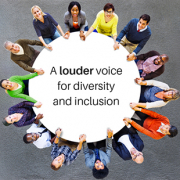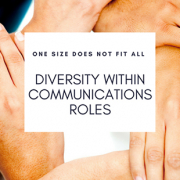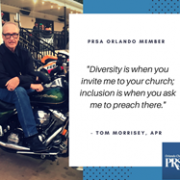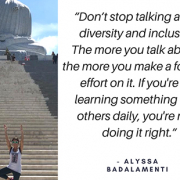What we learned at supper: PRSA members on diversity and inclusion
Authored by Alyssa Badalamenti, Diversity & Inclusion Chair for the PRSA Orlando chapter
The PRSA Orlando chapter recently selected 12 members of diverse backgrounds to participate in an open discussion on diversity and inclusion. During the first-time experimental event, Dinner, Diversity, and Dialogue provided an opportunity for sharing personal experiences followed by a focused brainstorm on ways to support PRSA members at their organizations and extend the chapter’s diversity and inclusion initiatives.
The participants ranged from a diverse demographic makeup of varied genders, races, religions, orientations, ages, experience levels and industries. We also engaged a facilitator, Bill Hertan, to guide our conversation. He brought with him 30 years of experience in leadership and organizational development. He has lead diversity and inclusion efforts at several Fortune 500 companies and runs his own consultancy.
We immediately heard comments such as, “I’ve been waiting for something like this,” and, “I’m so glad PRSA Orlando is stepping up to the plate to directly address diversity.”
We learned that diversity and inclusion guidelines could help members when they face challenges within their own organizations, and members could use support from PRSA by creating its own best practices.
But what does a diversity and inclusion model look like?
One idea was to mimic the PRSA Code of Ethics model and co-produce guidelines with other associations, specifically with human resource management groups. PRSA National has also created a Diversity and Inclusion toolkit for chapters to use to increase diversity and inclusion within their membership. This toolkit could serve as a starting point for organizations to create their own diversity and inclusion model.
While there are not yet structured diversity and inclusion policies for communications professionals like there are for ethics, diversity and inclusion starts with intentional workplace practices. There are common themes and insights that can be used to benchmark progress. For example, we learned that simply acknowledging how our chapter embraces diversity and how we aspire to improve our efforts resulted in positive feedback and discussion. Companies that endeavor to address the issue will also experience deepened morale.
Below are some key takeaways from our discussion at supper:
INITIAL THOUGHTS
- Talk about it, talk about it, TALK ABOUT IT.
- Never stop talking about ways to advance diversity and inclusion.
- “When I walk into a room, there’s nobody that looks like me.”
- Look around the table. Representation matters.
- It’s not just a box to check.
- It’s important to walk the walk, not just talk the talk.
FROM THEN TO NOW
- BACK THEN: Leave yourself outside of the door when you go to work.
- “I remember being told, ‘Don’t tell anyone in business because you’ll never work the same way again.’”
- TODAY: Bring your full self to work.
- “I came out at work by simply putting a photo of my family at my desk.”
HOW DOES DIVERSITY AND INCLUSION AFFECT OUR COMMUNICATION?
- Experiences define our world view.
- Our unique experiences shape how we communicate.
- Lead by example.
- We tend to look toward large organizations to lead the way in how we communicate to diverse audiences. Calling out prejudice is important, even if the company is not directly involved.
- Learn from mistakes.
- We also learn from other companies’ mistakes regarding diversity. Inaction can be perceived just as negatively as being tone-deaf.
- Executive involvement is important.
- Your level at the company typically affects your comfort level of addressing bias.
IT STARTS AT THE HR LEVEL
- Hire leaders who “get it.”
- Hire leaders who promote an environment of “being yourself.”
- Write it in the job description.
- Emphasize the importance of diversity and inclusion in job descriptions.
- Set the tone.
- Highlight the business case for expanding diversity and inclusion goals.
- Is it apparent in the company culture?
- Embed diversity and inclusion in the company culture in specific ways.
- Measure against goals.
- Could accountable actions as part of the employee review process help advance diversity and inclusion?
WHAT COMPANIES CAN DO FROM THE GET-GO:
- Acknowledge: Acknowledging that you want to improve diversity and inclusion in your organization speaks loudly.
- Communicate: Proper communication is the cornerstone of addressing diversity head-on.
- Represent: Provide visual representation of diversity in photos that convey a message of inclusion.
- Guide: Provide solid tools and guidelines of diversity and inclusion within your branding and strategy.
THE UNINTENDED CONSEQUENCES OF EQUALITY
- Intent is not equal to development.
- The recent example of Starbucks holding an employee diversity training day to address racial bias seemed like a “quick fix” attempt instead of providing a deeper development of its company culture.
- Not everyone feels comfortable talking about it.
- It’s wise to incorporate anonymous surveys to make sure everyone has a voice.
- AND, it doesn’t always need to be talked about.
- Making comments about differences, over-correcting, or including someone just to “check the box” can actually make that person feel less included or singled out.
- It takes more than one person.
- Just having a “Diversity and Inclusion Leader” is not enough. One person cannot represent an entire group.
CONSENSUS
At the very least, the consensus was that the public relations profession can promote the importance of diversity and inclusion within agencies, corporations and with clients through strategic counsel, communications and recruiting.
Companies should start by implementing or revamping diversity and inclusion policies. It’s equally important to hire diverse talent that reflects their audiences to better understand unique cultural perspectives.
By embedding diversity and inclusion within company culture, incorporating good workplace practices, and having a team that represents diverse individuals, companies can better relate to their audiences, avoid tone-deaf mistakes, and enhance their business.
We look forward to hearing more from you about how PRSA can help communications professionals address diversity and inclusion in the profession and at large. We welcome suggestions from all of our members. Please reach out to PRSA Orlando’s Diversity and Inclusion Chair, Alyssa Badalamenti, to continue the discussion and provide feedback.










